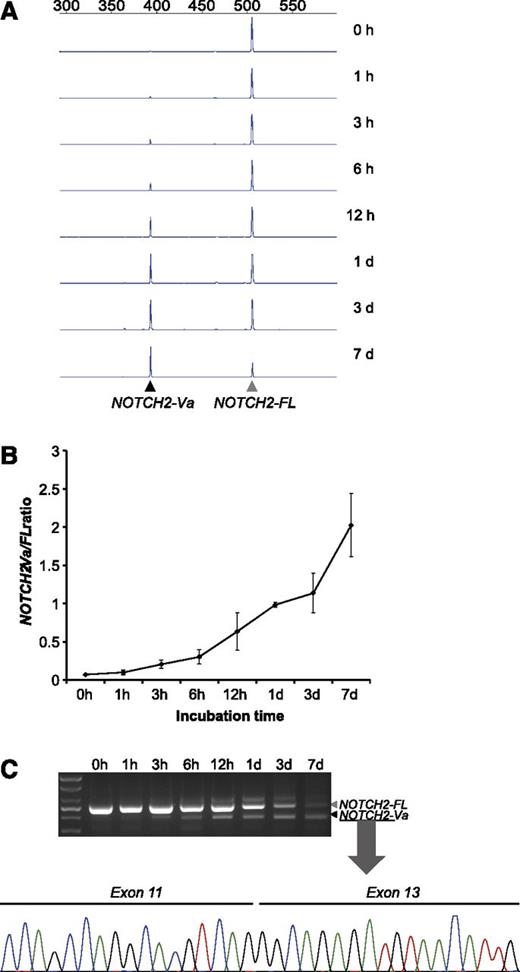To the editor:
In a recent study in Blood, Adamia et al have identified from an analysis on RNA sequencing and exon array data, that NOTCH2 and FLT3 gene missplicings are common events and potential targets in acute myeloid leukemia (AML).1 Among the splice variants, NOTCH2-Va resulting from a complete deletion of exon 12 (111 bp) was of particular interest because it was detected at a very high frequency (73%) in AML and its high expression was associated with poor outcome in patients with an intermediate-risk cytogenetics.
Incidentally, we found that this splice variant can be observed in normal hematopoietic cells undergoing apoptosis. To further investigate this phenomenon, we obtained 8 bottles of blood specimens each from 3 healthy individuals and stored samples in a dark chamber at room temperature. RNA was extracted immediately after venipuncture and also sequentially after scheduled storage times: 1, 3, 6, and 12 hours and 1, 3, and 7 days. Fluorescence polymerase chain reaction (PCR) and capillary electrophoresis using primers to detect NOTCH2-Va and full-length wild-type (WT) transcript (NOTCH2-FL)1 showed a gradual increase of NOTCH2-Va and a decrease of NOTCH2-FL during specimen aging (Figure 1A-B). Gel extraction and sequencing analysis for the abnormal PCR band confirmed skipping of the entire exon 12 of NOTCH2 (Figure 1C).
Expression of NOTCH2 splice variants according to specimen aging. (A) Fluorescence PCR and capillary electrophoresis shows an increasing amount of NOTCH2-Va variant compared with WT NOTCH2-FL as incubation time is prolongated. (B) The ratio of NOTCH2-Va to NOTCH2-FL increases with incubation time in all 3 replicates from 3 individuals. (C) Gel extraction and sequencing analysis of the NOTCH2-Va band confirms skipping of exon 12 that normally exist in WT NOTCH2. d, day(s); h, hour(s).
Expression of NOTCH2 splice variants according to specimen aging. (A) Fluorescence PCR and capillary electrophoresis shows an increasing amount of NOTCH2-Va variant compared with WT NOTCH2-FL as incubation time is prolongated. (B) The ratio of NOTCH2-Va to NOTCH2-FL increases with incubation time in all 3 replicates from 3 individuals. (C) Gel extraction and sequencing analysis of the NOTCH2-Va band confirms skipping of exon 12 that normally exist in WT NOTCH2. d, day(s); h, hour(s).
In line with our observations, another study also identified aberrant splicing of NOTCH2 in incubated normal blood cells by RNA sequencing,2 suggesting that the presence of NOTCH-Va may reflect the illegitimate splicing typically observed in specimen aging.3 The aberrant splicing is suggested to be widespread across the genome and associated with apoptosis pathways.4,5 However, Adamia et al1 have also demonstrated some functional consequences of the NOTCH2 splicing variants to induce downregulation of its target genes, such as HES1 and DTX1. Considering that deregulation of apoptosis is a key mechanism in the pathogenesis of AML,6 there might be some commonality between aging-related and leukemia-related missplicing events. And of special note, NOTCH2 is proven to have important roles on the regulation of apoptosis.7,8 The original investigators have suggested NOTCH2 variants as attractive targets for novel therapeutics, and we may say that the targeting strategy should be considered in the context of cell apoptosis. For clinical diagnostics, it is strongly recommended that these variants be tested using fresh specimens and to interpret the results with an understanding of the dynamics of splicing during cellular aging.
Authorship
Acknowledgments: This research was supported by the Basic Science Research Program through the National Research Foundation of Korea (NRF) funded by the Ministry of Education, Science, and Technology (NRF-2012R1A1A2043879).
Contribution: Y.H.M., S.-T.L., and J.R.C. designed the study, I.S.H. and S.S. performed experiments and analyzed the data, and I.S.H. and S.-T.L. wrote the manuscript.
Conflict-of-interest disclosure: The authors declare no competing financial interests.
Correspondence: Seung-Tae Lee, Department of Laboratory Medicine, Yonsei University College of Medicine, 50 Yonsei-ro, Seodaemun-gu, Seoul 120-752, Korea; e-mail: lee.st@yuhs.ac; and Jong Rak Choi, Department of Laboratory Medicine, Yonsei University College of Medicine, 50 Yonsei-ro, Seodaemun-gu, Seoul 120-752, Korea; e-mail: cjr0606@yuhs.ac.


This feature is available to Subscribers Only
Sign In or Create an Account Close Modal